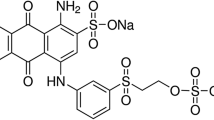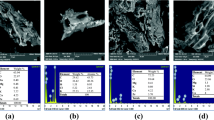Abstract
The present investigation explored the potential of biochar produced from groundnut shells in the removal of Reactive Orange 16 (RO16) in an aqueous solution. The characteristics of the biochar were evaluated using a thermogravimetric analyzer, scanning electron micrographs (SEM) with energy dispersive system (EDS), and Fourier transform infrared (FT-IR) spectra. The batch adsorption studies were conducted by determining the influencing parameters, namely, solution pH, sorbent dose, solution temperature, and initial RO16 concentration. Furthermore, adsorption isotherm models, namely, Freundlich, Langmuir, and Toth model were used to predict the sorption capacity of the model. Pseudo-first-order and pseudo-second-order kinetic models were developed to understand the sorption of the dye molecules at different time intervals. To evaluate the potential of the sorbent, regeneration studies were performed. A maximum removal efficiency of 73.67% and a sorption capacity of 11.05 mg/g were obtained.











Similar content being viewed by others
References
Abdolali A, Guo WS, Ngo HH et al (2014) Typical lignocellulosic wastes and by-products for biosorption process in water and wastewater treatment: a critical review. Bioresour Technol. https://doi.org/10.1016/j.biortech.2013.12.037
Yagub MT, Sen TK, Afroze S, Ang HM (2014) Dye and its removal from aqueous solution by adsorption: a review. Adv. Colloid Interface Sci.
Ravindiran G, Ganapathy GP, Josephraj J, Alagumalai A (2019) A critical insight into biomass derived biosorbent for bioremediation of dyes. ChemistrySelect
Gokulan R, Ganesh Prabhu G, Jegan J (2019) A novel sorbent Ulva lactuca-derived biochar for remediation of Remazol Brilliant Orange 3R in packed column. Water Environ Res. https://doi.org/10.1002/wer.1092
Thillainayagam BP, Saravanan P, Ravindiran G, Josephraj J (2021) Continuous sorption of methylene blue dye from aqueous solution using effective microorganisms-based water hyacinth waste compost in a packed column. Biomass Convers Biorefinery. https://doi.org/10.1007/s13399-020-01208-9
Pushpa TB, Josephraj J, Saravanan P, Ravindran G (2019) Biodecolorization of Basic Blue 41 using EM based composts: isotherm and kinetics. ChemistrySelect. https://doi.org/10.1002/slct.201901774
Gaddam K, Sivananaintha Perumal M, Ravindiran G (2020) Removal of lead metal ion using biowaste of Pithophora cleveana wittrock and Mimusops elengi. Energy Sources, Part A Recover Util Environ Eff. https://doi.org/10.1080/15567036.2020.1831657
Saravanan P, Josephraj J, Thillainayagam BP, Ravindran G (2021) Evaluation of the adsorptive removal of cationic dyes by greening biochar derived from agricultural bio-waste of rice husk. Biomass Conversion and Biorefinery. https://doi.org/10.1007/s13399-021-01415-y
Saravanan P, Josephraj J, Thillainayagam B P, Ravindiran G, (2021), Artificial neural network modelling for biodecolorization of Basic Violet 03 from aqueous solution by biochar derived from agro-bio waste of groundnut hull: kinetics and thermodynamics, Chemosphere, 130191https://doi.org/10.1016/j.chemosphere.2021.130191
Jegan J, Praveen S, Kumar BM et al (2021) Box–behnken experimental design for the optimization of basic violet 03 dye removal by groundnut shell derived biochar. Desalin Water Treat. https://doi.org/10.5004/dwt.2021.26495
Jegan J, Praveen S, Pushpa TB, Gokulan R (2020) Biodecolorization of basic violet 03 using biochar derived from agricultural wastes: isotherm and kinetics. J Biobased Mater Bioenergy. https://doi.org/10.1166/jbmb.2020.1969
Saravanan P, Thillainayagam BP, Ravindiran G, Josephraj J (2020) Evaluation of the adsorption capacity of Cocos Nucifera shell derived biochar for basic dyes sequestration from aqueous solution. Energy Sources, Part A Recover Util Environ Eff. https://doi.org/10.1080/15567036.2020.1800142
Jegan J, Praveen S, Bhagavathi Pushpa T, Gokulan R (2020) Sorption kinetics and isotherm studies of cationic dyes using groundnut (Arachis hypogaea) shell derived biochar a low-cost adsorbent. Appl Ecol Environ Res. https://doi.org/10.15666/aeer/1801_19251939
Lazaridis NK, Karapantsios TD, Georgantas D (2003) Kinetic analysis for the removal of a reactive dye from aqueous solution onto hydrotalcite by adsorption. Water Res. https://doi.org/10.1016/S0043-1354(03)00121-0
Al-Degs Y, Khraisheh MAM, Allen SJ, Ahmad MN (2000) Effect of carbon surface chemistry on the removal of reactive dyes from textile effluent. Water Res. https://doi.org/10.1016/S0043-1354(99)00200-6
Karacakaya P, Kiliç NK, Duygu E, Dönmez G (2009) Stimulation of reactive dye removal by cyanobacteria in media containing triacontanol hormone. J Hazard Mater. https://doi.org/10.1016/j.jhazmat.2009.08.037
Lenin Sundar M, Kalyani G, Gokulan R, Ragunath S, Joga Rao H (2021) Comparative adsorptive removal of Reactive Red 120 using RSM and ANFIS models in batch and packed bed column. Biomass Conversion and Biorefinery Accepted. https://doi.org/10.1007/s13399-021-01444-7
Kumar M, Sujatha S, Gokulan R, Vijayakumar A, Praveen S, Elayaraja S (2021) Prediction of RSM and ANN in the remediation of Remazol Brilliant Orange 3R using biochar derived from Ulva Lactuca. Desalination and Water Treatment 211:304–318. https://doi.org/10.5004/dwt.2021.26615
Ravindiran G, Jeyaraju RM, Josephraj J, Alagumalai A (2019) Comparative desorption studies on remediation of remazol dyes using biochar (sorbent) derived from green marine seaweeds. ChemistrySelect. https://doi.org/10.1002/slct.201901348
Hu X, Zhang X, Ngo HH et al (2020) Comparison study on the ammonium adsorption of the biochars derived from different kinds of fruit peel. Sci Total Environ. https://doi.org/10.1016/j.scitotenv.2019.135544
Kumar M, Gokulan R, Sujatha S et al (2021) Biodecolorization of Reactive Red 120 in batch and packed bed column using biochar derived from Ulva reticulata. Biomass Convers Biorefinery. https://doi.org/10.1007/s13399-020-01268-x
Priya AK, Gokulan R, Vijayakumar A, Praveen S (2020) Biodecolorization of remazol dyes using biochar derived from ulva reticulata: isotherm, kinetics, desorption, and thermodynamic studies. Desalin Water Treat. https://doi.org/10.5004/dwt.2020.26098
Gokulan R, Ganesh Prabhu G, Avinash A, Jegan J (2020) Experimental and chemometric analysis of bioremediation of remazol dyes using biochar derived from green seaweeds. Desalin Water Treat. https://doi.org/10.5004/dwt.2020.25339
Gokulan R, Avinash A, Prabhu GG, Jegan J (2019) Remediation of remazol dyes by biochar derived from Caulerpa scalpelliformis - an eco-friendly approach. J Environ Chem Eng. https://doi.org/10.1016/j.jece.2019.103297
Gokulan R, Prabhu GG, Jegan J (2019) Remediation of complex remazol effluent using biochar derived from green seaweed biomass. Int J Phytoremediation. https://doi.org/10.1080/15226514.2019.1612845
Langmuir I (1918) The adsorption of gases on plane surfaces of glass, mica and platinum. J Am Chem Soc. https://doi.org/10.1021/ja02242a004
Weber TW, Chakravorti RK (1974) Pore and solid diffusion models for fixed-bed adsorbers. AIChE J. https://doi.org/10.1002/aic.690200204
Haghseresht F, Lu GQ (1998) Adsorption characteristics of phenolic compounds onto coal-reject-derived adsorbents. Energy and Fuels. https://doi.org/10.1021/ef9801165
Author information
Authors and Affiliations
Corresponding author
Ethics declarations
Conflict of interest
The authors declare no competing interests.
Additional information
Publisher's note
Springer Nature remains neutral with regard to jurisdictional claims in published maps and institutional affiliations.
Rights and permissions
About this article
Cite this article
Muralikrishnan, R., Jodhi, C. Biodecolorization of Reactive Orange 16 using biochar produced from groundnut shell (Arachis hypogaea): batch, isotherm, kinetic, and regeneration studies. Biomass Conv. Bioref. 13, 8891–8902 (2023). https://doi.org/10.1007/s13399-021-01710-8
Received:
Revised:
Accepted:
Published:
Issue Date:
DOI: https://doi.org/10.1007/s13399-021-01710-8




